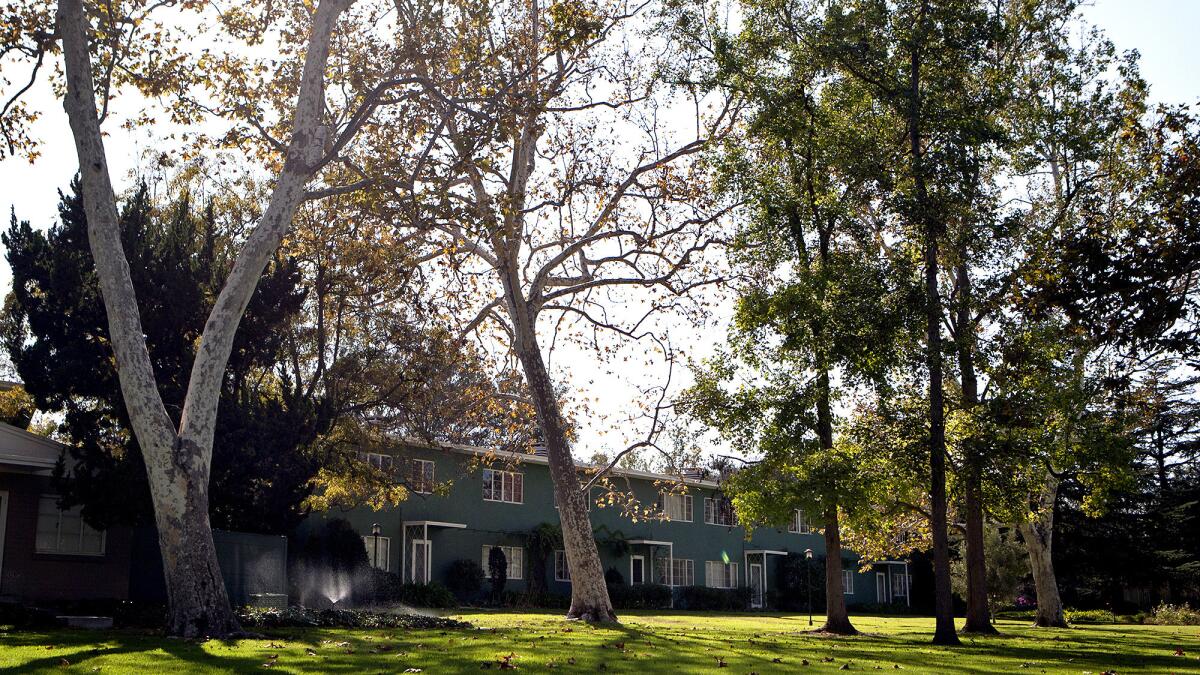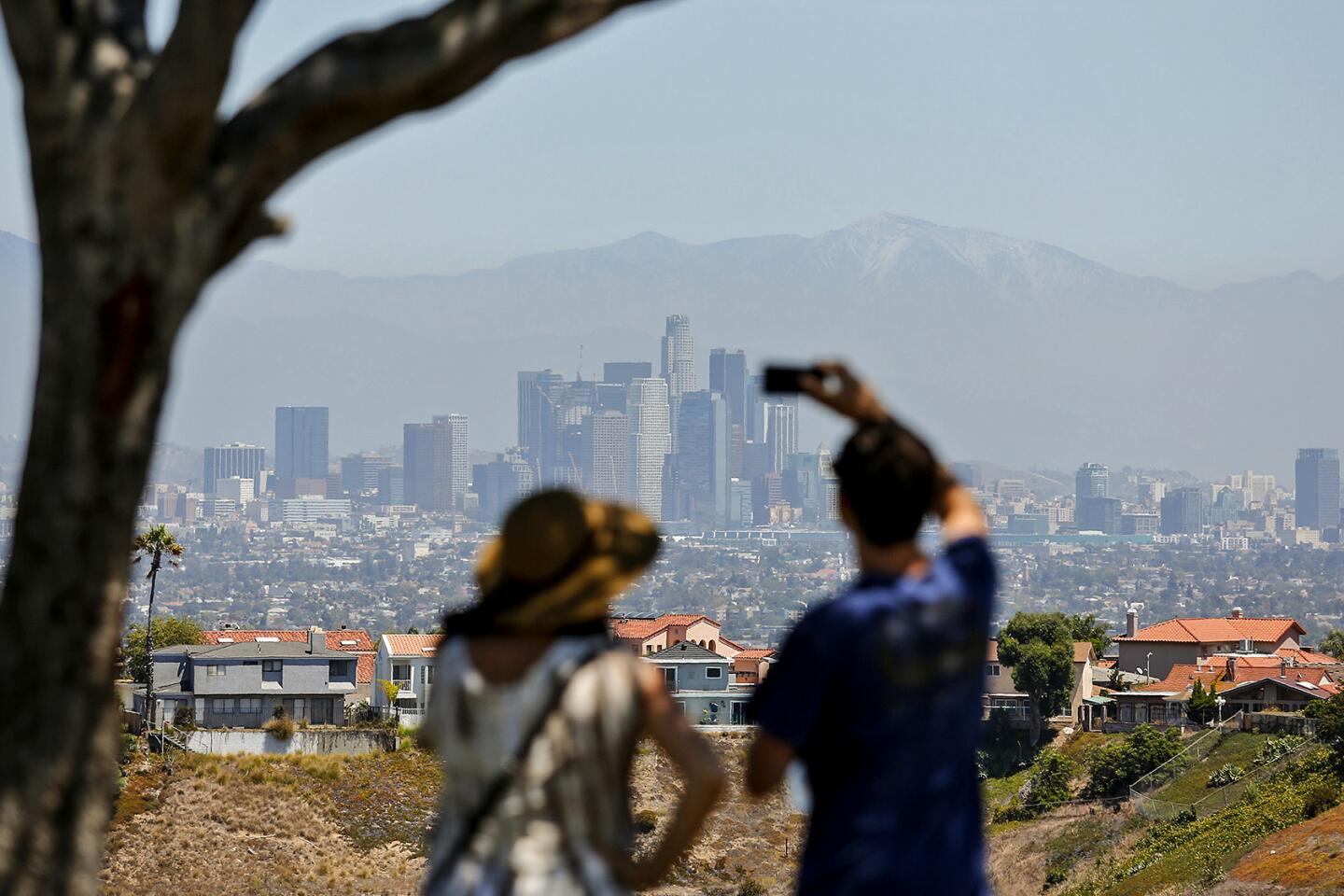Neighborhood Spotlight: Baldwin Hills/Crenshaw finds itself in transition again
- Share via
Few vantage points offer better views of L.A. than those in Baldwin Hills, where millions of years of sedimentary deposits in the ancient sea left behind a series of high domes on the flat surface of the basin.
Those rugged heights offer spectacular vistas for hikers, provide hillside perches for homes in one of the country’s most affluent African American neighborhoods and conceal the remains of one of the richest deposits of oil in the Southland.
The steep, crumbling terrain of the Hills kept developers at bay for most of the early expansion of L.A. There was no streetcar, and the vast, open plains around it provided a seemingly endless supply of land to subdivide and develop.
It was easier to build at the foot of the hills, where Crenshaw Boulevard and its trolley line offered the promise of a vibrant, walkable commercial center to build a neighborhood around.
So Baldwin Hills sprouted oil derricks instead of homes, and coyotes and oilmen were left alone up there with the views. Below, a real estate boom swept across Los Angeles, and by the 1920s, street after street of tidy, modest homes — many of which were designed according to covenants governing not just the appearance of new homes, but who could buy and live in them — had appeared.
At the end of World War II, a shift began. Japanese Americans who returned to L.A. after their release from internment camps slowly began to move west from the neighborhoods around Exposition Park. They settled in what became one of the city’s great nisei communities, eventually building the Crenshaw Square shopping center, which was emblematic of their desire to foreground Japanese culture in the neighborhood.
There were shifts in the way Angelenos lived, as well.
On the other end of Coliseum Street from Crenshaw Square, construction had wrapped up on a groundbreaking garden apartment complex then known as Baldwin Hills Village. Built on a massive 68-acre site that was surrounded by empty fields, it contained more than 620 apartment units in a number of two-story buildings scattered across a park-like setting. The apartment block had now gone suburban.
Although racial covenants were struck down by the courts in the 1940s, it wasn’t until the 1960s that black Angelenos were able to truly exercise their right to live where they chose. They began to move into the Crenshaw District and into the homes that had been built atop Baldwin Hills beginning in the 1950s.
The neighborhood’s affluence, combined with the star power of such famous residents as Tina Turner, Tom Bradley, Ice Cube and architect Paul Williams, led to it being dubbed the Black Beverly Hills — although its views have the other Beverly Hills beat, hands down.
Neighborhood highlights
A multicultural heritage: The Japanese American and African American experiences in Baldwin Hills and Crenshaw have created a rich cultural legacy in the neighborhood.
Such great heights: With panoramic views of L.A., Baldwin Hills offers some of the best hillside living in the city — not to mention the best view of the fireworks on the Fourth of July.
An easy commute: Convenient to Culver City and USC, and served by the Expo Line with the Crenshaw Line on its way, it’s a great neighborhood for those who hate long commutes.
Neighborhood challenges
Managing change: The new Crenshaw Line is a great investment in one of our most culturally significant neighborhoods, but rising commercial rents along the train’s path may change its character.
Expert insight
Katrina Manning, a real estate agent and owner of Homes by Katrina, sees the Baldwin Hills/Crenshaw area as a neighborhood in transition.
“It’s mostly an older community,” Manning said. “But we’re seeing a lot of young families moving in, particularly young families with kids.”
New development and its central location are also drawing those who left the area years ago for the Valley and other more distant communities, she said.
“When you have kids, it changes your perspective; you don’t want to spend all your time traveling,” she said.
Looking ahead, Manning believes projects such as a new Kaiser Permanente medical campus and the Metro Crenshaw/LAX Line will keep the area moving in a positive direction.

Market snapshot
In February, based on nine sales, the median sales price for single-family homes in the 90008 ZIP Code was $755,000, according to CoreLogic. That was a 10.8% increase in median sales price over the same month the previous year.
Report card
Within the boundaries of Baldwin Hills-Crenshaw is Baldwin Hills Elementary, which scored 864 out of 1,000 in the 2013 Academic Performance Index. Hillcrest Drive Elementary had a score of 705, and Coliseum Street Elementary scored 654. Lou Dantzler Preparatory Charter High scored 630, and Susan Miller Dorsey Senior High had a score of 611.
MORE FROM HOT PROPERTY
Lynn Swann scores a contemporary home in Hancock Park for $3.08 million
Sale of Holmby Hills estate of early filmmaker Allan Dwan is a wrap at $18.8 million
Ex-Cal coach Cuonzo Martin sells Piedmont home for half a million over asking price
More to Read
Sign up for Essential California
The most important California stories and recommendations in your inbox every morning.
You may occasionally receive promotional content from the Los Angeles Times.










